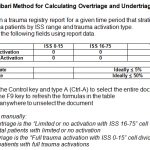The number of motorcyclists has been increasing over the past decade. At the same time, the number of states repealing their helmet laws is increasing. The evidence is convincing that the number and severity of brain injuries is decreased with helmet use. But what about spine injury?
Many arguments against wearing helmets given by riders are derived from a report in 1986 by Goldstein*. One of the issues cited in this paper is the potential increase in cervical spine injuries due to the weight of the helmet. A recently published study using the National Trauma Data Bank (NTDB) corroborates several smaller studies which show that this just isn’t so.
All motorcycle collisions in the NTDB involving adults were analyzed by logistic regression. Missing data was compensated for using standard statistical techniques. Nearly 41,000 cases had complete records for analysis. About 77% of riders were wearing helmets, and the overall mortality was 4%.
Nonhelmeted riders suffered the following statistically significant differences:
- A higher proportion of severe head injury (19% vs 9% with helmets)
- Higher incidence of shock on admission (6% vs 5% with helmets)
- Higher injury severity score (ISS) (14.7 vs 13.4 with helmets)
- Higher crude mortality (6.2% vs 3.5% with helmets)
- Higher incidence of cervical spine injury (5.4% vs 3.5% with helmets)
Bottom line: Motorcyclists wearing helmets had a 22% reduction in the likelihood they would sustain a cervical spine injury in a crash. This is in addition to decreases in shock, injury severity and death. These data need to be considered when the future of helmet laws is considered in any state looking at repealing them.
References:
- Motorcycle helmets associated with lower risk of cervical spine injury: debunking the myth. J Amer Col Surgeons 212(3):295-300, 2011.
- *The effect of motorcycle helmet use on the probability of fatality and the severity of head and neck injury. Evaluation Rev 10:355-375, 1986.


